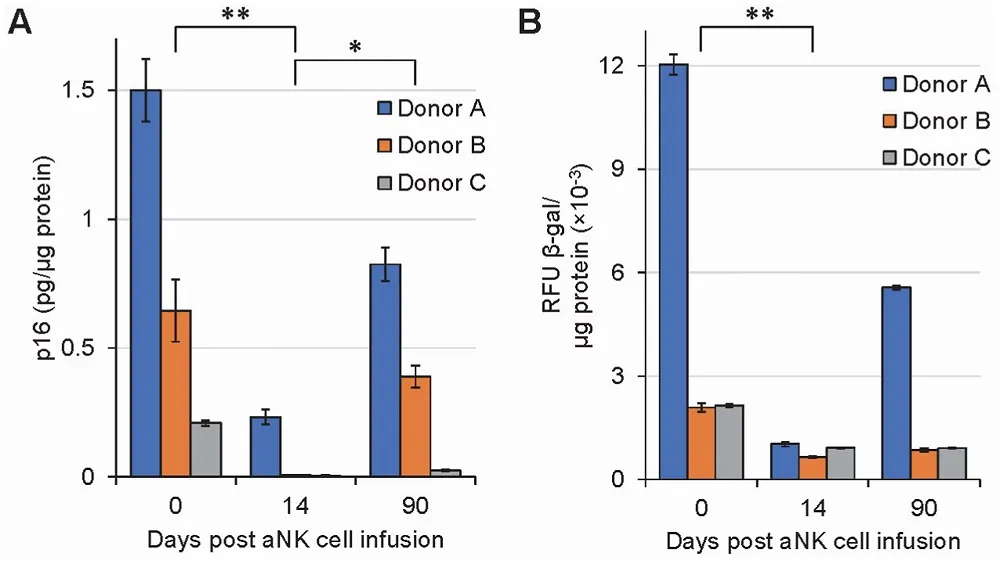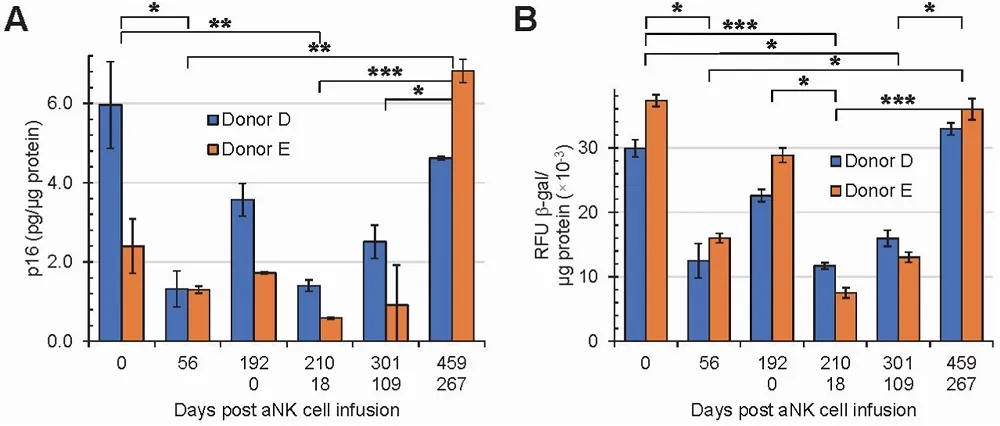In a study recently published in Biochemistry and Biophysics Reports, researchers have shown that growing natural killer (NK) cells and re-introducing them back into the human bloodstream reduces senescence markers in a wide variety of immune cells.
Peripheral blood mononuclear cells
This research focuses on peripheral blood mononuclear cells (PBMCs), a category that includes T cells, NK cells, B cells, and other immune cells that constantly send signals to one another [1]. Senescence in these cells drives senescence and other aspects of aging in other organs [2]. Normally, NK cells keep the senescent cell population under control [3], a task that goes unaccomplished if they, themselves, become senescent. While the idea of using NK cells to fight senescence has been approached, previous studies in this area were restricted to mouse models and in vitro experiments, on which we have previously reported.
A protocol has already been developed for extracting NK cells from people, propagating and activating them, and then returning them to their donors [4]. These cells are known as autologous NK (aNK) cells. Therefore, these researchers took the logical next step: with a total of five volunteers, they set out to determine whether or not aNK cells are a viable approach for affecting senescence in human beings.
Improving effectiveness
The first thing the researchers did was determine if they were correctly isolating and expanding the correct portion of cells. They found that after harvesting PBMC cells and applying their activation technique, an average of 91% of the resulting cells were aNK cells. This number varied between donors; while the sample size is too small to determine statistical significance in this respect, the 70-year-old donor’s PBMCs resulted in the fewest aNK cells compared to the other donors, who were all in middle age.
The researchers then determined if the technique they were using to activate and propagate the cells was effective against natural targets. The activated cells were considerably more effective than their unaffected counterparts, destroying larger percentages of cancer cells and senescent cells at lower doses in vitro.
Three of the volunteers, including the 70-year-old, received one billion aNK cells and were monitored for 30 days. The senescence markers p16 and ß-gal both declined dramatically in all three of these individuals’ PBMCs after two weeks; the 70-year-old’s returned to approximately half of its initial high value after 30 days. One of the younger donors, who has inflammatory bowel disease, had many inflammatory markers substantially downregulated by this treatment.

The final two volunteers underwent a much longer-term experiment, with two billion aNK cells injected at two separate times: once at the beginning and once after 192 days. The effects were similar; the senescence markers were substantially decreased at the beginning of the experiment, rose over time, and were reduced once more by the second infusion of aNK cells.

No adverse effects were detected in any of these volunteers.
Conclusion
While there were only a small handful of participants, this study is an eye-opening proof of concept and suggests that aNK cells can be valuable in at least temporarily ameliorating systemic inflammation and potentially delaying other aspects of aging. It may one day be possible to affect the cells that give rise to aNK cells, restoring their effectiveness and providing a powerful, long-term weapon against inflammaging. That day might be a long way off, however, so a biotechnology company might determine that guiding an aNK cell-based therapy through clinical trials is a wise investment.
Literature
[1] Grievink, H. W., Luisman, T., Kluft, C., Moerland, M., & Malone, K. E. (2016). Comparison of three isolation techniques for human peripheral blood mononuclear cells: cell recovery and viability, population composition, and cell functionality. Biopreservation and biobanking, 14(5), 410-415.
[2] Yousefzadeh, M. J., Flores, R. R., Zhu, Y. I., Schmiechen, Z. C., Brooks, R. W., Trussoni, C. E., … & Niedernhofer, L. J. (2021). An aged immune system drives senescence and ageing of solid organs. Nature, 594(7861), 100-105.
[3] Sagiv, A., Burton, D. G., Moshayev, Z., Vadai, E., Wensveen, F., Ben-Dor, S., … & Krizhanovsky, V. (2016). NKG2D ligands mediate immunosurveillance of senescent cells. Aging (Albany NY), 8(2), 328.
[4] Kundu, S., Gurney, M., & O’Dwyer, M. (2021). Generating natural killer cells for adoptive transfer: expanding horizons. Cytotherapy, 23(7), 559-566.




